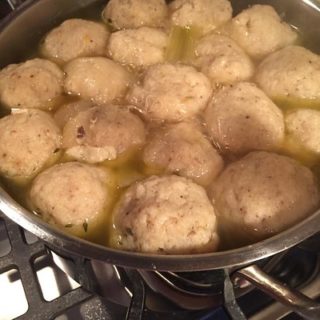Matzo ball soup is more than just a meal—it's a symbol of tradition, comfort, and family. For many, it represents the essence of Jewish heritage, especially during Passover. But for others, like the author of this article, it’s a personal journey filled with experimentation, nostalgia, and a quest for perfection. In this piece, we explore the history, cultural significance, and practical tips for making matzo ball soup, while also delving into the personal stories that make this dish so special.
A Recipe Rooted in Tradition

Matzo ball soup has deep roots in Ashkenazi Jewish culture, often referred to as "Jewish penicillin" due to its comforting and healing properties. The dish consists of a chicken broth base filled with soft, fluffy matzo balls made from matzo meal, eggs, and fat. While traditional recipes may vary, the core elements remain consistent: a rich broth, tender chicken, and the signature dumplings that float in the soup.
The author recalls their first attempt at making matzo ball soup, which was met with mixed results. They found that their homemade matzo balls were tough, unlike the ones made by their mother-in-law, which melted in the mouth. This experience highlights the challenge of recreating a dish that is deeply tied to memory and tradition. As the author notes, even small changes—like substituting fresh ginger with maror (bitter herbs) or using powdered instead of fresh ingredients—can significantly affect the outcome.
The Science Behind the Dumplings

Making perfect matzo balls is both an art and a science. The key lies in the balance of ingredients and technique. According to the author, the dough should be allowed to rest before forming the balls, which helps the matzo meal absorb moisture and prevents the dumplings from falling apart in the soup. This step is crucial, as it ensures the balls maintain their shape while still being light and airy.
The recipe provided includes specific measurements and instructions, such as using 3/4 cup of matzo meal, 3 large eggs, and 3 tablespoons of oil. These ingredients are whisked together until smooth, then refrigerated for 30 minutes. This process allows the mixture to firm up, making it easier to form into balls without sticking to the hands.
Tips for Success

For those new to making matzo ball soup, the author offers several helpful tips:
- Use bone-in chicken for added flavor, but remove the skin before adding it to the soup.
- Make the dough ahead of time and store it in the refrigerator overnight.
- Let the soup simmer slowly to ensure the matzo balls cook evenly without breaking apart.
- Adjust seasoning to taste, adding salt or pepper as needed.
These tips not only simplify the process but also help achieve the desired texture and flavor. The author also emphasizes the importance of allowing the matzo balls to rest before cooking, as this step can make a significant difference in the final result.
The Role of Culture and Family

Beyond the recipe itself, matzo ball soup holds cultural and emotional significance. For many families, it’s a dish passed down through generations, each version carrying the unique touch of the person who prepared it. The author’s mention of their mother-in-law’s matzo balls and their own attempts to replicate them illustrates how food can become a bridge between past and present.
In some households, the preparation of matzo ball soup is a communal effort, with multiple family members contributing to the process. This shared activity reinforces the idea that food is not just sustenance but also a way to connect with loved ones and preserve traditions.
Modern Adaptations and Variations
While traditional recipes often use chicken fat (schmaltz), the author notes that vegetable or canola oil can be used as a substitute. This flexibility makes the dish more accessible to those who may not have access to traditional ingredients. Additionally, the recipe allows for customization, such as adjusting the amount of chicken or adding extra vegetables.
Some variations include using different types of broth, such as beef or vegetable, depending on personal preference. Others may choose to add noodles or other ingredients to create a heartier meal. These adaptations show how matzo ball soup can evolve while still maintaining its core identity.
Conclusion: A Dish That Feels Like Home
Matzo ball soup is more than just a meal—it's a reflection of heritage, a comfort during difficult times, and a reminder of the people and traditions that shape our lives. Whether you're making it for a holiday, a sick day, or simply because you crave something warm and familiar, the act of preparing this dish connects you to something larger than yourself.
As the author concludes, "You can’t go wrong with chicken and dumplings—in any form!" This sentiment captures the essence of matzo ball soup: a simple yet profound dish that brings joy, warmth, and a sense of belonging. Whether your matzo balls are perfectly round or slightly irregular, they carry the same spirit of love and tradition that makes this soup so special.